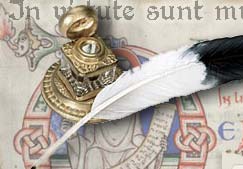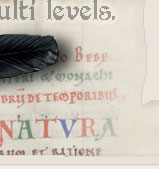It’s a topsy-turvey world
getting somewhere now –
below is the middle portion of f.116r – notice how where the gallows coincidentally line up vertically (circled) the upper 3 lines drift upwards – (other examples can be found on other pages)
 [img=http://a.imageshack.us/img217/6886/linesup.th.jpg]http://
[img=http://a.imageshack.us/img217/6886/linesup.th.jpg]http://Below is an example from f.49v showing how the tails of the ‘9’ EVA(y) are longer when above a gap between ‘words’ in the line below (examples of this and the EVA(q) tail doing the same can be found on many pages)
 [img=http://a.imageshack.us/img440/5009/enlarge49v0001.th.jpg]http://
[img=http://a.imageshack.us/img440/5009/enlarge49v0001.th.jpg]http://What causes these anomalies – clearly they indicate that the line underneath must have been written before the one above it –
The obvious thing to do is turn the page upside down – now the aligned margin is on the right and the ragged one on the left indicating it was written from right to left – I thought at first that this must mean it was written backwards – not necessarily so -
 [img=http://a.imageshack.us/img294/2161/herbacapillusmaior0001.th.jpg]http://
[img=http://a.imageshack.us/img294/2161/herbacapillusmaior0001.th.jpg]http://In the above image I first drew the ‘plant’ in my own fashion, then simply turned the page upside down – writing normally it is simple to leave a ragged margin on the left – to line up the right hand margin is done by simply adjusting the spaces between words or stretching or compressing as necessary – when this doesn’t quite work as in line 4 simply put in a null – I suggest the VM author did this to look like a rubrication mark – it also explains its predominate line position.
Note how the ‘header’ (Edgar Allan Poe), when the page is plant orientated appears in the bottom right as is usual in the VM. (It’s herba Capillus maiore)
Yes, it’s a self portrait – I was a hippie in the 60’s, now I’m a hippie in his 60’s – even painted my old Ford Popular psychedelic – the multi coloured spiral hubcaps used to make the pedestrians dizzy, but worst of all drivers behind kept running in the back of me whilst trying to figure out what the images on the boot were – I’m sure some of them looked exactly like the ‘chinese’ glyphs on f.1r
I digress
I think the above clearly shows the layout, direction of writing and construction of the page -
Now the only question is what does it say – what is his cipher?
I’ve always believed, because of the sheer volume of it & it’s age, that this would be a very simple cipher.
I think all he has done is re-orientate some of the letters (just as he did the page) – some letters he left untouched (there’s no way to change the letter ‘o’ – upside down, reversed, - it’s all the same to me) – some he simply distorted –
I suggest the following key:-
 [img=http://a.imageshack.us/img80/3392/voykey0003.th.jpg]
[img=http://a.imageshack.us/img80/3392/voykey0003.th.jpg]There are at least 3 different kinds of ‘6’ EVA(y) ‘9’ – those with a curved tail – those with a straight tail – those with the loop connected and those without – each may be a different letter – but all have been lumped together by those who transcribed it – the differences may help decide what represents what. Same applies to EVA(d) ‘8’.
Of course it may not say anything sensible – just as the plants are copies of plants from other herbals that have been distorted, recombined etc. the text, if copied may also have been distorted, recombined etc.

With several (accidentally) lookalike symbols substituting for the same letter it reminds me a little of the of the following cipher where this was done deliberately –
1821 82374 29 30 84541. 185270 924 184 182 82460. 84314 8842 31 8599420 31 8355 7239241 8218. 726 85400 021 - from ‘The Times’ Sep. 1853
Charles Babbage waged a war against street musicians who disturbed his peace, sending his man after them, taking out prosecutions etc. – I find it amusing to think that ‘Thou voice of my heart’ (it comes from a popular song of the time) could be being sung beneath his window whilst he was coming up with ‘Thou image of my heart...’ in the above cipher!
I digress again
Back to the Voynich –
EVA(f) & (p) are probably nulls/rubrication
Now as everything is reversed and upside down EVA(iin) is M and is not in cipher (this is the way it was written as the first letter of a word (see previous post on positons of letters from a French Herbal) – as this appears to be in Italian it will hardly ever appear as a final letter – in the middle of a word it must have been abbreviated here. (Incidentally the marginalia read as ‘michiton oladabas...’ beginning with four strokes this has been assumed to begin ‘mi...’ - the first stoke being curved is nothing more than a flourish and I think should be read as ‘ni...’ probably says ‘ni chiton’ (no clothes)? But if the palaeographers can’t even read what a bit of plaintext says, what chance have they got with a cipher – my God it’s just as well I’m here to help!?
EVA(o) upside down, reversed, it’s all the same to me – is now a prominent final just as in Italian
EVA(k & t) think these are both the same and represent L or LL (see similarity with Da Vinci’s L’s in a previous post) though why it is always double L when one would do is a bit of a mystery to me.
EVA(q) I believe this is probably equivalent to the ‘tyronian’ 7 and is just another old way of writing ‘et’ I think it was once written looking like a plus sign or a number 4, I’m sure I’ve seen plaintext examples where it is tacked on to the following word – though here it has ended up on the end of the word.
Those with a mathematical approach may like to recalculate the entropy or word distribution in view of the above 2
i.e. qokaiin okaiin otaiin qotaiin are all the same it’s just that 2 of them have ‘et’ tacked on the front – it doesn’t matter whether its reversed for this calculation.
EVA(y) this is the 9 which upside down becomes a 6 – the 6th letter of the alphabet is F (I’ve stated before I think the VM is the work of a child – just someone who thought he’d make his own ‘book’ - of course those who’ve spent years working on this will not take kindly to that suggestion – but this is what I see) – those familiar with old writing will appreciate the difficulty of distinguishing an F from an S written in the old style – the VM author either didn’t or couldn’t - to complicate matters further, but not deliberately, the old style of writing an ‘I’ at the start of a word can look similar to a 9 so it also appears as a 6 etc.
EVA(d) ‘8’ again this has several varieties – presumably with the flat top it will be the substitute for ‘g’ – otherwise for ‘y’ and middle position’i’ as ‘i’ & ‘y’ used to be equivalent (I think) – I’m a bit confused with this as the ‘i’ was also written like a ‘j’ in first & final positions – not being a palaeographer I’m probably mixing styles from different centuries or countries!! – press on Tony
EVA(l) this stands for D it is either an upside down 4(old style) 4th letter of alphabet is D or it is simply a D that is written in reverse
EVA(e) this is E and is simply written in reverse
EVA(h) is R written in the old style that looks like a modern number 2 (it will not appear at the start of a word in this fashion as it was written differently in that case - and EVA(ch) is RE another common Italian ending
EVA(Sh) I take in most cases to be RE with the little arc representing an abbreviation for a missing letter - probably M or N
EVA(s) must be ‘e’ with some abbreviation ascender making it ‘er’ ‘em’ ‘en’ ‘et’ – not sure
EVA(a) this is a ‘u’ unaltered or an inverted’a’ – think EVA(o) must also stand for ‘a’ in some cases
Applying the key to f.1v - I very tentatively came up with (line for line):-
tagore do fiore ? fiore dai ferelore too
fiorme tui orelo tori dorme tui il doi dore dallo torne
mai dore fiore dorle dore il dore ifreel dol dorme dollo
fiore d oi doli odoi doi doli serle doi doere ? ??ore do o et
irle ire dod ogore feredoi dallo dorme d orle dore illore
irneorme muolo fiol bere tui duor?e t?ui dorme solo
fioll ore bereo ? ?ai oellore doi
dui fiorelol irlle s??rnelli imre irleorle irlle oi
fiore tagollo fiolld orei freo to tare seeli
tu turle tare bereldo do magore fenrel
the above does contain some Italian words (some common ones at that) – unfortunately the only language I know is English, so every word I have to look up in a modern dictionary – 500 odd years ago there were no dictionaries, no standardised spellings (In an English MS of that age I’ve noticed the writer spell the same word 3 different ways on the same page!!) – also it’s possibly gobbledygook like the plant drawings - so I turned to have a look at some of the labels to see if I could see a connection twix them and the accompanying image – didn’t have too much success there either which I put down to my lack of language skills, the fact that some cipher characters have multiple alternatives etc. etc. – still I think the system and key are basically sound – perhaps some palaeographer of medieval Italian can make something of it looking at it this way.
Incidentally the very first word (header) on the first page can be read as ‘Marci’ (now that name sets a few bells ringing)
For anyone looking for a precise set of steps to follow to decipher this – please consult the rule book for the game of ‘Mornington Crescent’







